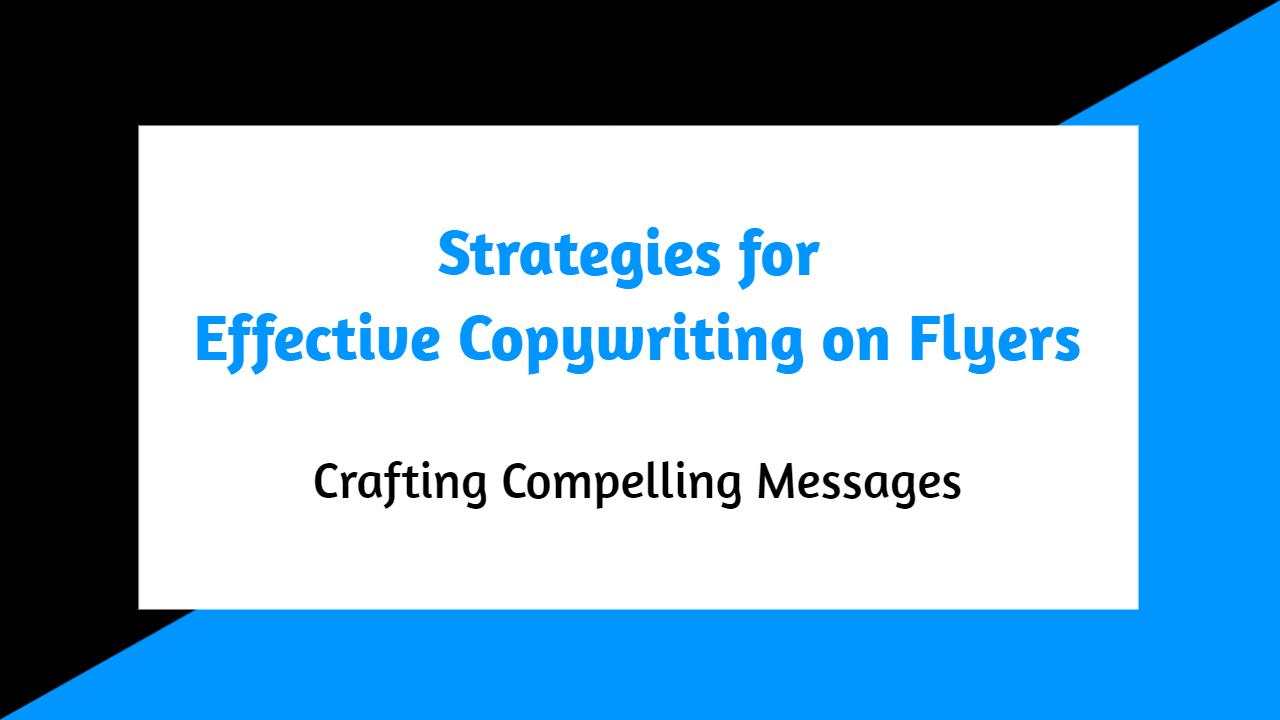Strategies for Effective Copywriting on Flyers: Crafting Compelling Messages

Flyers are an effective marketing tool that can grab people’s attention and communicate a message quickly and concisely. However, to make your flyers truly impactful, it’s crucial to have compelling copywriting that engages the reader and motivates them to take action. In this article, we will explore strategies for effective copywriting on flyers that captivate your audience and drive results.
Also, take your flyer designs to the next level with our comprehensive blog on ‘How to Create a Flyer‘. Learn design techniques that will make your flyer stand out and captivate your audience.
1. Understanding Your Target Audience
Before you start writing copy for your flyer, it’s essential to understand your target audience. Consider their demographics, interests, and pain points. This knowledge will enable you to tailor your message to resonate with them effectively.
2. Defining Clear Objectives
Clearly define the objectives of your flyer. What action do you want your audience to take? Is it to visit your website, attend an event, or make a purchase? Having a clear objective in mind will help you craft a focused and persuasive message.
3. Creating a Powerful Headline
The headline is the first thing that grabs the reader’s attention. It should be short, attention-grabbing, and convey the main benefit or value proposition of your offering. Use powerful words that evoke emotion and curiosity.
4. Utilizing Persuasive Language
To make your copy more persuasive, use language that speaks directly to your audience’s desires and needs. Focus on the benefits they will gain from your product or service. Incorporate words that create a sense of urgency, exclusivity, or scarcity.
5. Keeping the Message Concise
When it comes to copywriting on flyers, brevity is key. Keep your sentences and paragraphs short and straightforward. Use bullet points or numbered lists to convey information in a concise and scannable format.
6. Highlighting Key Benefits
Clearly communicate the key benefits of your product or service. Explain how it solves a problem or improves the lives of your target audience. Use specific examples or testimonials to add credibility and make your message more compelling.
7. Including a Strong Call to Action
Every flyer should have a clear and compelling call to action (CTA). Tell your audience exactly what you want them to do next, whether it’s visiting a website, calling a phone number, or visiting a physical location. Use action verbs and create a sense of urgency to encourage immediate response.
8. Designing with Visual Hierarchy
The visual hierarchy of your flyer plays a significant role in capturing attention and guiding the reader’s eyes. Use contrasting font sizes, colors, and layouts to highlight the most important information. Ensure that your copy is easily readable amidst the design elements.
9. Choosing an Appropriate Font
Selecting the right font is crucial for readability and visual appeal. Use a font that aligns with your brand identity and is easy to read. Avoid using too many different fonts in a single flyer as it can create a cluttered and unprofessional look.
10. Using Captivating Images
Incorporate relevant and high-quality images that complement your copy. Visuals can enhance the overall impact of your flyer and create a stronger emotional connection with your audience. Ensure that the images are crisp, clear, and aligned with your brand message.
11. Incorporating Testimonials
Include testimonials or positive customer reviews to build trust and credibility. Social proof is a powerful persuasion technique. Highlight the experiences and satisfaction of previous customers to reinforce the value and credibility of your offering.
12. Adding Contact Information
Make it easy for your audience to get in touch with you. Include your contact information such as phone number, email address, and website URL. Ensure that this information is prominently displayed on the flyer so that interested individuals can reach out easily.
13. Proofreading and Editing
Before printing or distributing your flyers, thoroughly proofread and edit the content. Check for any grammatical errors, spelling mistakes, or inconsistencies. Ensure that the copy is clear, concise, and error-free to maintain a professional image.
14. A/B Testing for Optimization
Consider conducting A/B testing with different versions of your flyer to determine which copy elements are most effective. Test different headlines, calls to action, or visual layouts to optimize your flyer’s performance and maximize its impact.
15. Tracking and Analyzing Results
Once your flyers are distributed, track and analyze the results of your campaign. Monitor metrics such as response rate, website visits, or conversions to evaluate the effectiveness of your copywriting strategies. Use these insights to refine future campaigns.
Conclusion
Crafting compelling messages on flyers requires a combination of creativity, strategic thinking, and an understanding of your target audience. By implementing the strategies outlined in this article, you can create impactful flyers that grab attention, engage your audience, and drive desired actions. Remember to continuously test, track, and refine your copy to ensure maximum effectiveness.






